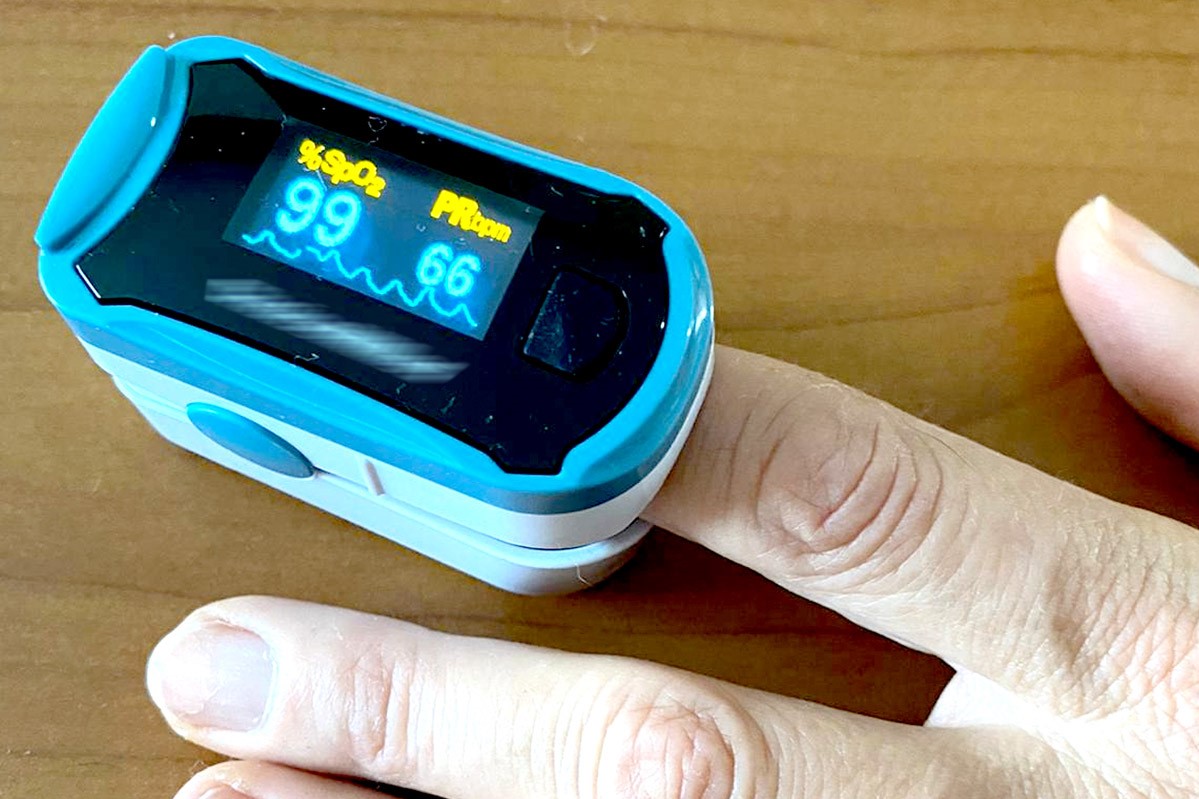
Equipment: what is a saturation oximeter (pulse oximeter) and what is it for?
The saturation oximeter (or pulse oximeter) is a device used to measure the oxygenation of the blood, to find out whether the lungs are able to take in sufficient quantities from the air they breathe
WHAT IS THE PULSE OXIMETER USED FOR?
A saturation meter (or pulse oximeter) is a device used to measure the oxygenation of your blood and is useful for finding out whether your lungs are able to take in enough of it from the air you breathe.
The pulse oximeter is normally used in patients with asthma, chronic bronchitis, COPD, pneumonia, etc…
It can be useful to have one in the home to monitor the oxygenation of patients with fever, cough, shortness of breath (dyspnoea) and Covid: you can buy one in a pharmacy or on the internet.
WHAT ARE THE VALUES SHOWN ON THE PULSE OXIMETER?
Normal oxygenation values (reported as SpO2) range from 97% upwards – but values as low as 94% are not worrying, especially in patients with known lung diseases.
If oxygenation falls below 90 per cent in people with high fever, coughing and shortness of breath, the emergency number should be contacted: there are people at the Operations Centre who know how to give the right indications and assess the case correctly.
In addition to the oxygenation values, most saturimeters also report the frequency of heartbeats or pulse rate: when reading this, it is important not to confuse the two data.
HOW TO USE THE SATURATION METER?
In order to use the saturation meter efficiently, it is necessary for your fingers to be warm: so rub your finger well before measuring and try on different fingers to choose the one that provides the best measurement.
The highest value to be considered, lower ones are not considered, and it is best to repeat the measurement on several fingers.
Some patients, such as those suffering from Raynaud’s Phenomenon or diseases that cause poor circulation in the fingers, may show falsely lower oxygen saturation values: by warming the fingers well, this problem can, at least in part, be avoided.
PULSE OXIMETER, OBSTACLES TO MEASUREMENT
There are also some conditions that can hinder correct measurement, including:
nails that are too long: they must be cut, otherwise the fingertip will not fall within the range of the laser beam used to measure oxygen saturation;
nail polish: modern nail polishes do not generally cause lower values, but it is better to remove them.
“gel nails’ (those that are glued on top of normal nails): they may generate false results. It is not clear whether this is due to the formulation of the gel or to the fact that these applications are usually also particularly long.
Read Also
Emergency Live Even More…Live: Download The New Free App Of Your Newspaper For IOS And Android
Basic Understanding Of The Pulse Oximeter
Ambulance: What Is An Emergency Aspirator And When Should It Be Used?
The Purpose Of Suctioning Patients During Sedation
Supplemental Oxygen: Cylinders And Ventilation Supports In The USA
Basic Airway Assessment: An Overview
Respiratory Distress: What Are The Signs Of Respiratory Distress In Newborns?
EDU: Directional Tip Suction Catheter
Suction Unit For Emergency Care, The Solution In A Nutshell: Spencer JET
Airway Management After A Road Accident: An Overview
Tracheal Intubation: When, How And Why To Create An Artificial Airway For The Patient
What Is Transient Tachypnoea Of The Newborn, Or Neonatal Wet Lung Syndrome?
Traumatic Pneumothorax: Symptoms, Diagnosis And Treatment
Diagnosis Of Tension Pneumothorax In The Field: Suction Or Blowing?
Pneumothorax And Pneumomediastinum: Rescuing The Patient With Pulmonary Barotrauma
ABC, ABCD And ABCDE Rule In Emergency Medicine: What The Rescuer Must Do
Multiple Rib Fracture, Flail Chest (Rib Volet) And Pneumothorax: An Overview
Internal Haemorrhage: Definition, Causes, Symptoms, Diagnosis, Severity, Treatment
Assessment Of Ventilation, Respiration, And Oxygenation (Breathing)
Oxygen-Ozone Therapy: For Which Pathologies Is It Indicated?
Difference Between Mechanical Ventilation And Oxygen Therapy
Hyperbaric Oxygen In The Wound Healing Process
Venous Thrombosis: From Symptoms To New Drugs
What Is Intravenous Cannulation (IV)? The 15 Steps Of The Procedure
Nasal Cannula For Oxygen Therapy: What It Is, How It Is Made, When To Use It
Nasal Probe For Oxygen Therapy: What It Is, How It Is Made, When To Use It
Oxygen Reducer: Principle Of Operation, Application
How To Choose Medical Suction Device?


